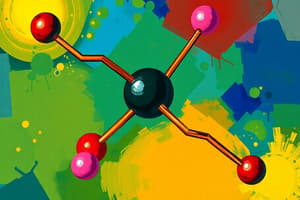Podcast
Questions and Answers
Which of the following statements about the structure of organic compounds is true?
Which of the following statements about the structure of organic compounds is true?
- They are ring-shaped with carbon atoms in the same plane. (correct)
- They consist solely of single bonds.
- They can exist in a three-dimensional form.
- They are always linear in structure.
What is the hybridization type of the carbon atoms in benzene?
What is the hybridization type of the carbon atoms in benzene?
- SP3
- SP2 (correct)
- SP
- SP4
Which reaction involves the formation of substituted benzene derivatives?
Which reaction involves the formation of substituted benzene derivatives?
- Nucleophilic substitution
- Condensation reaction
- Addition reaction
- Electrophilic substitution (correct)
Which rule determines the number of electrons forming the pi-bond in aromatic compounds?
Which rule determines the number of electrons forming the pi-bond in aromatic compounds?
What is an example of a mono-substituted benzene derivative?
What is an example of a mono-substituted benzene derivative?
What is produced when benzaldehyde is formed from salicylic acid?
What is produced when benzaldehyde is formed from salicylic acid?
Which process is used to reduce carbonyls and halide bonds in the preparation of benzene?
Which process is used to reduce carbonyls and halide bonds in the preparation of benzene?
What is a characteristic of Friedel-Craft alkylation?
What is a characteristic of Friedel-Craft alkylation?
Which of the following reactions is NOT typically associated with carboxylic acids?
Which of the following reactions is NOT typically associated with carboxylic acids?
What is one method for synthesizing phenols from benzene?
What is one method for synthesizing phenols from benzene?
What characterizes aromatic compounds?
What characterizes aromatic compounds?
What is the primary source for the extraction of key aromatic hydrocarbons?
What is the primary source for the extraction of key aromatic hydrocarbons?
Which of the following compounds is a heterocyclic aromatic compound?
Which of the following compounds is a heterocyclic aromatic compound?
Which of the following statements about benzene is true?
Which of the following statements about benzene is true?
What is the molecular formula for benzene?
What is the molecular formula for benzene?
Which of the following aromatic amino acids is NOT listed in the content?
Which of the following aromatic amino acids is NOT listed in the content?
What distinguishes aliphatic hydrocarbons from aromatic hydrocarbons?
What distinguishes aliphatic hydrocarbons from aromatic hydrocarbons?
Which compound is NOT an aromatic hydrocarbon?
Which compound is NOT an aromatic hydrocarbon?
Flashcards are hidden until you start studying
Study Notes
Aromatic Compounds
- Aromatic compounds contain cyclical rings of carbon atoms with alternating single and double bonds, creating a delocalized electron system known as an aromatic ring.
- The term "aromatic" originates from the past grouping of molecules based on odor, but it is not related to their smell in modern usage.
- Heterocycles are aromatic rings where one or more carbon atoms are replaced with other atoms such as oxygen, nitrogen, or sulfur.
- Molecules without aromatic rings are called aliphatic.
- Many aromatic compounds play vital roles in biochemistry, particularly the four aromatic amino acids: histidine, phenylalanine, tryptophan, and tyrosine, which are essential building blocks of proteins.
- Aromatic compounds are essential to industry, particularly benzene, toluene, ortho-xylene, and para-xylene, which are used as precursors to manufacture various chemicals and polymers.
Benzene
- Benzene has the molecular formula C6H6.
- It is a colorless and highly flammable liquid with a sweet smell.
- Benzene is a natural component of petroleum.
- Due to the cyclical delocalized electron system, benzene is classified as an aromatic hydrocarbon.
Aromaticity
- Organic compounds with aromatic properties share specific characteristics:
- They are ring-shaped with carbon atoms in the same plane (co-planar).
- They have conjugated double bonds, where double bonds alternate with single bonds.
- The carbon atoms have SP2 hybridization.
- They obey Huckle's rule, which states that the number of pi electrons in the ring must be equal to 4n + 2, where 'n' is a non-negative integer.
Nomenclature of Benzene Derivatives
- Mono-substituted Benzene:
- The substituent prefix is combined with the word "benzene" (e.g., aminobenzene, nitrobenzene).
- Some mono-substituted benzene derivatives have special names.
- Di-substituted Benzene:
- Substituent positions are indicated by numbers.
- Common prefixes like "ortho", "meta", and "para" are used for 1,2-, 1,3-, and 1,4-disubstituted derivatives, respectively.
- Tri-substituted Benzene:
- Substituent positions are indicated by numbers.
Preparation of Benzene
- Benzene can be prepared by the following methods:
- Reduction of benzoic acid and its salts with sodalime (NaOH + CaO).
Chemical Reactions of Benzene and its Derivatives
- Electrophilic Substitution Reactions:
- Nitration: Introduction of a nitro group (NO2).
- Sulphonation: Introduction of a sulfonic acid group (SO3H).
- Halogenation: Introduction of a halogen atom (e.g., chlorine or bromine).
- Friedel-Crafts Alkylation: Introduction of an alkyl group (R).
- Friedel-Crafts Acylation: Introduction of an acyl group (RC=O).
- Addition Reactions:
- Addition reactions are less common in benzene due to its stability.
Orientation in Electrophilic Aromatic Substitution
- The position of the incoming substituent on the benzene ring depends on the already existing substituent(s).
- Activating groups: Electron-donating groups (e.g., -OH, -NH2, -CH3) activate the ring towards further electrophilic substitution, usually directing to ortho- and para-positions.
- Deactivating groups: Electron-withdrawing groups (e.g., -NO2, -COOH, -SO3H) deactivate the ring towards further electrophilic substitution, usually directing to meta-positions.
Aldehydes and Ketones
- Benzaldehyde:
- The common name for benzaldehyde is benzoic aldehyde.
- Preparation of Benzaldehyde:
- Benzaldehyde can be prepared by various methods, including the oxidation of toluene with manganese dioxide (MnO2) or chromic acid (H2CrO4).
Cycloaddition Reactions
- Cycloaddition reactions involve the formation of a new ring by joining two or more molecules.
- Diels-Alder reaction is a commonly used cycloaddition reaction for the synthesis of cyclic compounds.
Synthesis of Ketones
- From Grignard Reagent:
- Ketones can be synthesized by reacting a Grignard reagent (R-MgX) with an ester.
- By Oxidation of Secondary Alcohols:
- Ketones can be produced by oxidizing secondary alcohols using oxidizing agents like potassium permanganate (KMnO4) or chromic acid (H2CrO4).
- With Active Methylene Compounds:
- Ketones can be synthesized by the reaction of active methylene compounds (containing CH2 groups adjacent to carbonyl groups) with aldehydes or ketones.
Carboxylic Acids
- Benzoic Acid:
- It is a white solid organic compound with the formula C7H6O2.
- Salicylic Acid:
- Contains a hydroxyl group (-OH) at the ortho position to the carboxyl group (-COOH).
- Phthalic Acid:
- It has two carboxyl groups attached to a benzene ring.
- Cinnamic Acid:
- Contains a carboxyl group at the para position to the phenyl group (-C6H5).
- Phenyl Acetic Acid:
- Has a carboxyl group attached to a benzene ring and a methylene (-CH2-) group in between.
Reactions of Carboxylic Acids
- With Sodium Hydroxide (NaOH):
- Carboxylic acids react with NaOH to form carboxylate salts, releasing water.
- With Sodium Carbonate (Na2CO3):
- Carboxylic acids react with Na2CO3 to form carboxylate salts and release carbon dioxide (CO2) and water.
- With Ammonium Hydroxide (NH4OH):
- Carboxylic acids react with NH4OH to form ammonium carboxylate salts, releasing water.
- With Lithium Aluminum Hydride (LiAlH4):
- LiAlH4 is a powerful reducing agent that can reduce carboxylic acids to primary alcohols.
- Esterification:
- Carboxylic acids react with alcohols in the presence of an acid catalyst (e.g., H2SO4) to form esters and water.
- Nitration:
- Carboxylic acids can undergo nitration with nitric acid (HNO3) in the presence of a sulfuric acid (H2SO4) catalyst to introduce a nitro group (-NO2).
Phenols
- Phenol:
- A colorless crystalline solid with the formula C6H5OH.
- It is a weak acid and is used in the production of many chemicals, including plastics, resins, and pharmaceuticals.
- Catechol:
- Contains two hydroxyl groups (-OH) at the ortho positions to each other.
- Resorcinol:
- Contains two hydroxyl groups at the meta positions to each other.
- Quinol:
- Also known as hydroquinone, contains two hydroxyl groups at the para positions to each other.
Synthesis of Phenols
- From Salicylic Acid:
- Phenol can be produced by the decarboxylation of salicylic acid.
- From Benzene:
- Phenol can be prepared by sulfonation of benzene followed by alkali fusion.
- From Aniline:
- Production of phenol from aniline involves diazotization followed by hydrolysis.
Reactions of Phenols
- Acidity of Phenols:
- Phenols are weak acids, and they can react with strong bases to form phenoxide salts.
- Electrophilic Substitution Reactions:
- Phenols are more reactive towards electrophilic substitution than benzene because of the electron-donating effect of the hydroxyl group.
- Oxidation Reactions:
- Phenols can be oxidized to quinones.
Exam Questions
- A) Put the right sign or the wrong sign:
- 1- Benzene reacted with methylchloride in the presence of sodium metal to form 2-methyl benzene only.
- WRONG: This reaction is an example of Friedel-Crafts alkylation, which can lead to multiple products.
- 2- Salicaldehyde is reduced into formylbenzene by Zinc dust.
- WRONG: Zinc dust reduces aldehydes to primary alcohols.
- 3- Aniline compound obey Huckle’s rule.
- RIGHT: Aniline has a six-membered aromatic ring with six pi electrons, satisfying Huckle's rule (4n+2 = 6).
- 1- Benzene reacted with methylchloride in the presence of sodium metal to form 2-methyl benzene only.
- B) Toluene reacted nitric acid in the presence of sulfuric acid to form A and B. Then Toluene reacted with C to formylbenzene. Formylbenzene is oxidized in air to form D. D reacted with acetyl chloride to afford E. Please write the chemical structures of the A, B, C, D, E compounds.
- A: A mixture of ortho-nitrotoluene and para-nitrotoluene.
- B: Meta-nitrotoluene.
- C: Chromium(VI) oxide (CrO3) or Potassium permanganate (KMnO4) in acidic conditions.
- D: Benzoic acid.
- E: Benzoic anhydride.
Studying That Suits You
Use AI to generate personalized quizzes and flashcards to suit your learning preferences.




